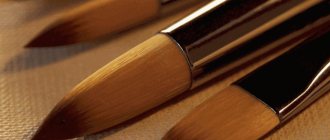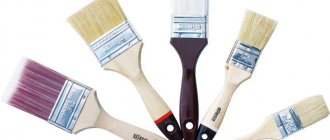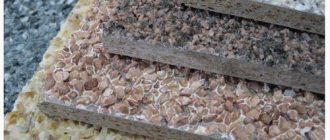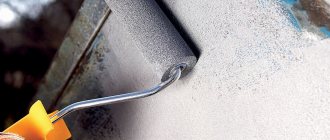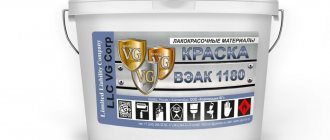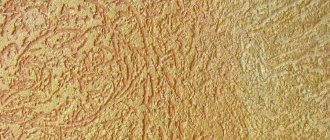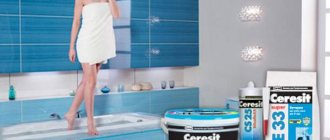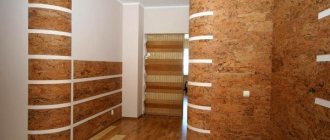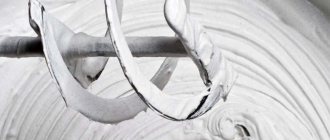When they say “flute brush,” the question arises: what is it? It won’t immediately occur to you that every home has such a tool, or at least had one during the next renovation. What is flutz? Externally, this is a flat universal brush that is suitable for all types of paint and varnish work. For its production, natural pig bristles are used (from the spinal part of the carcass). Sometimes horse or badger hair is added. The handle uses a wooden or plastic base framed with a metal rim.
Briefly about the flute brush
Initially, the tool was used by artists to paint pictures, since the strokes on the canvas with the help of a flute were smooth and uniform. Its maximum size was up to 50 mm. Over time, such brushes began to be used for repair work. Now its sizes vary from 10–50 mm to 100–160 mm.
According to GOST, the brush is marked KF. Suitable for painting flat and decorative surfaces, does not leave streaks. Even despite the wide variety of building materials, the KF flute brush occupies a leading position in sales in the markets of many countries.
In this article, we will look at what types of brushes there are, its scope, main characteristics, how to properly prepare the tool for painting, and also compare the pros and cons of natural and synthetic bristles.
If you decide to paint a surface or an object yourself, purchase several brushes of different sizes. The small one can be used to paint hard-to-reach places and joints, while the large one is easier to work on flat areas.
Artificial brushes
The main advantage of such folded brushes is their low cost. A brush from usually costs less than $5, while natural fiber will require 5-7 times the cost. Thanks to the use of modern synthetic materials, the bristles of a synthetic brush can have increased absorbency, which many artists like because it reduces working time. The third advantage can be considered increased wear resistance, which is important when working on surfaces such as wood, concrete, and plaster.
The main area of application of synthetic brushes is the application of paints and varnishes with increased fluidity. Natural pig bristles cannot absorb such materials at a sufficient level to properly treat the surface.
If you don’t know which brush to choose for a particular type of work, be sure to consult the seller or experienced painters when purchasing. This will not only save your time, but will also improve the quality of the result.
Types and scope
Many professional builders use the following types of construction equipment for painting:
- Regular flute brush. The bristles are made from pig wool and are recommended for painting work, which includes painting, stenciling, and surface painting. Available in different sizes from 20 to 160 mm. The brush is flat, the bristles are attached to it with a metal rim, maybe with a wooden or plastic handle.
- Maklovitsa is the largest brush. Horse hair is used for lint. Used for applying primer or wallpaper glue. The shape can be round or flat. Not used for decorative and paintwork.
- Swing brush. Available in large sizes, as it is used for whitewashing walls and ceilings. It is not suitable for surface painting and decorative work. Its main dimensions are 60–65 mm, the length of the pile is 100 mm.
- Round paneled brush. Available in sizes from 20 to 50 mm. Used for painting decorative panels or long strips.
- Radiator. It is used for painting hard-to-reach places, most often for painting heating radiators. Available in curved form with an extended handle. Its width can be from 15 to 30 mm.
As you can see, each tool has its own purpose. But among all the above-mentioned types, the most popular is the regular flute brush. It is very simple to explain this pattern; thanks to the versatility of the tool, it can be used for painting smooth surfaces, pipes, complex decorative areas, and large areas.
Important! Using a flute brush, you can apply even and thin strokes, while significantly saving paint consumption. This happens thanks to the natural bristles that are used to make it.
How to choose the right painting tool
Multifunctional brushes are not currently sold in stores, so before purchasing, you need to decide on the type of future work, the area, and the type of material used for coating. Experienced builders prefer natural fibers to synthetic ones. It has better characteristics than synthetics, and with careful care they will last a long time. But natural pile will not always be better than nylon. Nylon threads have water-repellent properties, so they are perfect for working with water-based paints and varnishes.
Before purchasing, it is important to check the quality of the pile. To do this, carry out a simple test: bend the fiber slightly on the surface and then release it. If the beam has returned to its original state, then the brush is good and will serve the master for a long time. Bent or broken hairs indicate low “one-time” quality. All hairs fit tightly to each other, do not stick out, do not split or fall out.
Experienced builders prefer natural fibers to synthetic ones.
The next step is to check the handle: it should be firmly fixed to the metal rim or to a wide base with pile. This guarantees the accuracy of the work, and at the time of painting the brush will not break at an unexpected moment.
Brushes for painting are also selected according to the size of the working part, that is, the size of the beam and its rigidity. It is important to take into account the coverage area, the type of surface being treated and the type of base coloring material.
Paint brushes are fairly cheap tools that are difficult to cover surfaces well. The master painter should have several types in stock to hide defects and correct mistakes.
The master painter should have several types in stock to hide defects and correct mistakes.
Characteristics of a flute brush
Thanks to its design, the fluted flat brush allows you to perform any paintwork with high quality. At the same time, during work you will have significantly less smudges and splashes, which are usually left behind by the muzzles. It is comfortable to hold in your hands due to the correct flat shape of the handle, which significantly reduces worker fatigue.
Thanks to the natural bristles, the required amount of paint is absorbed, which allows you to paint the surface without frequent dipping of the tool. The bristles do not fall out during operation, as they are tightly attached to the handle with an iron retainer (rim).
Advice! Do not use a flute brush on untreated surfaces. To begin with, the wall should be cleaned of dirt and primed. Otherwise, the fibers will cling to uneven bulges and after a while the brush will begin to go bald. This can happen on brick, concrete or wood surfaces.
Tips for choosing
When choosing a flute brush for painting, pay attention to its bristles. If the pile is elastic and rough, the painting will be done in even stripes. Soft bristles absorb a large amount of paint, which can cause smudges and streaks to remain on the surface. If possible, purchase brushes of medium hardness.
The length of the bristles plays an important role when choosing painting tools: if the flute brush is flat, with elongated bristles, you will get uneven strokes on the surface. And it will absorb a large amount of paint, that is, the consumption of material will increase. Brushes with short bristles are best used in small areas, as frequent swings of the tool will exhaust the worker. But such painting will be more accurate and accurate.
When purchasing painting tools, check the bristles for elasticity. Run your finger over the surface of the bristles. If it has returned to its original position - this is a high-quality painting tool, the lint remains sticking out in different directions - do not waste your money, during the work the lint will begin to fall out and the painting will be ruined.
If you are doing stencil painting, you won't find a better tool for applying paint. If the brush is thin, it will accurately fill the area to be painted and will not create bumps or streaks. For painting work, it is better to purchase tools of different sizes. One brush will be 15 mm wide - you can carefully paint corners and curves with it, the second - 50 mm and with an elongated handle to carefully handle all hard-to-reach places, take the third 100 mm or larger in size - for working on large areas.
To check the strength of the bristles of a flute brush, lightly pull the bristles; if a small tuft remains in your hands, it means the tool is of poor quality and is not worth purchasing.
When purchasing, you can bend the pile in different directions. If you notice that it breaks and falls out, the bristles are too dry, painting with such a tool will not be of high quality. You should not purchase tools for painting work at a low price; in this case, savings can lead to costs for repainting the surface.
In the video: characteristics of the Intertool flute brush.
Types of brushes
There are many types of paint brushes, which differ from each other both in design, size, and bristle length. These differences play a significant role when choosing the right tool for a particular type of finishing work, and therefore it is advisable to be able to understand the types of brushes and their purpose in order to choose a painting kit for the upcoming repair correctly. The main types of products are:
Handbrake (KR, KRO, KRS)
These products usually have impressive dimensions (the size of the brush can reach almost 30 centimeters), and the bristles are secured to a short handle with a thick metal rim. Traditionally, tools of this type are used in priming or painting small surfaces. It is recommended to use hand brushes when working with slow-drying paint or primer mixtures that do not contain solvents. The main advantage of the products is their increased resistance to aggressive substances.
Handbrake
Trimming brushes (ШТ)
They are used in work when there is a need to create a roughness effect on a base coated with paint. To achieve the desired result, the brush requires constant care; it must be perfectly clean. Moreover, work with a tool of this type is structured in a special way: the paint is applied with single, sweeping strokes using ShT brushes. Trimming brushes can only be used on already painted surfaces!
Trimming brush
Mack brush (KMA)
This tool can have a round shape (the diameter of the ink part is up to 170 millimeters) or rectangular (width up to 200 millimeters). They are valued for their high productivity and the absence of the need for additional leveling (flattening) of the surface after painting with paint. The tool can only be used for water-based paints or aqueous solutions.
Brush
Fly brushes (KM)
They are used both for painting substrates and for washing and whitewashing them. The tool is convenient to work on large areas. Products are made from natural hair with a small addition (no more than 30%) of synthetics. The key advantage of this type of instrumentation is its high resistance to moisture, solvents, and other aggressive paint and coating components.
Flying brush
Flute brushes (KF)
Designed for work on leveling the coating on already painted surfaces. Using brushes allows you to smooth out the roughness of the strokes from the initial coloring. They can also be used as an independent tool if there is a need to create a final glossy layer.
Flute brush
File brushes (FKF)
This tool is small in size, the diameter of the ink part does not exceed 18 millimeters. The use of small brushes is advisable when you need to draw a neat and narrow line; most often the tool is used to create a harmonious transition at the junction of bases painted in different colors.
Panel brush
Flat brushes (KP)
A popular type of product is flat brushes (FB), used in painting, priming work, and when applying varnish compositions to the base. The tool is produced in a wide range of sizes - from 35 to 100 sizes. Size in this case means the width of the handle of the product. The bristles of flat brushes always have a cone shape.
Flat brush
Preparing the instrument for painting
Before you start painting any surface, you should prepare your brush. Most people are mistaken if they think that this is an optional process. First, place a flat brush in a jar of soapy water for 10 minutes, then it must be thoroughly washed and dried. This procedure will remove any remaining dust, grease, or broken fibers.
Imagine how, when painting, an unprepared brush can ruin the quality of the surface being treated. When the bristles are saturated with water, they will become much more pliable, will be able to better absorb paint, and the strokes will be smooth and clean.
Sometimes, when choosing brushes, you noticed that many of them have bristles sticking out in different directions. It is not recommended to pull them out, as all the bristles will quickly fall out during painting. It is also impossible to trim, since during paint and varnish work furrows on the surface will be noticeable. It is best to wet the tool and make a few strokes on the concrete surface. This way the bristles will be aligned and adjacent to each other.
Preparing the brush before painting
Some people think that after purchasing a paint brush made of natural or synthetic bristles, you can immediately start using the tool; this is a common misconception. Almost all flat brushes are not prepared for painting. The first thing after purchasing a brush is to thoroughly wash it in soapy water and then dry it thoroughly. This is important to do to remove broken lint, dust, grease and other contaminants that can reduce the quality of the applied paint layer. In addition, straightened, clean bristles are more pliable, they perfectly absorb paint and varnish material, making it possible to paint cleanly and evenly.
Brush Cleaning Procedure
If you want the brush to last as long as possible, after completing paint work, carry out the cleaning procedure:
- Squeeze the tool against the can to remove excess paint.
- Pour white spirit into the container and rinse the bristles.
- Take out the brush and dry it with a dry cloth.
It is not recommended to leave painting tools in solvent, as this will destroy the structure of the pile, both natural and synthetic.
If you decide to stop painting, wet a rag with white spirit and wrap it around your brush, then place the tool in a plastic bag. In this form it can be stored for several days. You can’t put the tools in ordinary water; it’s impossible to clean the bristles, the paint will simply dry on it, and you’ll have to throw away the brush. It is also not recommended to leave the tool in a container with paint for a long time. The pile will absorb the coloring material, but at the same time its structure will begin to deplete and lead to fragility.
Recommendations from experts
- If a new or previously used brush has protruding bristles, it is not recommended to pull them out, as this will gradually destroy all the bristles. Also, you cannot cut them with scissors or burn them with fire, as this will destroy the natural structure of the hairs. The best option is to smooth the bristles onto the concrete surface for 5 minutes, thanks to this there will be no bristles sticking out in different directions, all the bristles will become straight and even, in addition, the excess thickness of the bristles will be removed.
- When purchasing a flat brush with a width of 50 mm, 75 mm, or any other, it is advisable to lightly pull all the bristles. If there are a few fibers or fragments left in your hand, then the brush is of poor quality and it is better not to buy it.
- When buying a brush, you should bend the bristles alternately in one direction and the other. If the elasticity of the villi is poor, or if places where they are broken are visible, it is better to immediately discard such a tool; it is of poor quality, its bristles are overdried.
- Be sure to thoroughly rinse the pile after each painting, thanks to this the tool will serve for a long time. Do not leave the brush in the paint can, and it is also not recommended to wipe the bristles too hard. Experts advise cleaning as follows: squeeze the paint well, for example, into a container with paint and varnish material, then rinse it in a solvent, then dry.
- If you need to stop painting for a while, you should not leave the brush in White Spirit; it is advisable to wet a rag with solvent, then wrap the lint in the rag and cover it with a plastic bag. The instrument can be stored in this form for several days. And if you leave the bristles immersed in white spirit, this will certainly damage the natural or synthetic bristles, and can also lead to swelling of the wooden handle.
What is better - natural or synthetic bristles?
One of the important factors that affects the quality and cost of the brush is the bristles. It can be of three types:
- natural;
- combined;
- synthetic.
Paint brushes with natural bristles are the most practical, durable, resistant to various solvents and expensive. Badger wool, horse and pig hair are used to make them. The price of the tool will depend on the color of the tool’s bristles: the darker it is, the better quality and more expensive it will be.
Natural brushes are often used when working with oil, acrylic and latex paints. Their composition can be ruined by a synthetic or combined tool.
The combined flat brush consists of 60% natural fibers and 40% synthetic fibers. This bristle composition is used to make small-sized painting tools. These can be panel and radiator brushes, the width of which does not exceed 50 mm.
Today, painting tools with synthetic fibers are in no way inferior to natural compositions. Thanks to modern technologies, manufacturers began to create brushes with artificial bristles, which have increased absorption of paints and varnishes. This significantly reduces work time. Professional painters choose such tools for painting concrete and wooden surfaces.
Synthetic brushes are used to work with highly fluid paints and varnishes. Natural pile will absorb paint in excess, causing smudges and uneven transitions to form on the surface.
Painting the house is the final stage of finishing work. Using a brush and paints, you can create a unique play of colors, smooth transitions. In this process, the painter acts as an artist who creates a masterpiece. With the help of flute brushes you can perform the most precise and meticulous work. Hence, it is better to purchase the best quality tools.
Recommendations for choosing (1 video)
Different types of flute brushes (26 photos)
Features of paint brushes
To obtain an optimal coating result, the brush must have certain quality characteristics:
- good paint absorption;
- uniform paint release;
- good and uniform distribution;
- high stability of the bristle shape;
- easy brush control;
- durability.
For a brush to meet these requirements, it must consist of a certain material and have a certain structure. Materials play a special role here.
Absolutely any paint brush consists of the following parts:
- Pen. The convenience of the master’s work depends on its quality. The STORCH brand offers the most optimal option - a well-polished, unvarnished handle made of durable beech wood with an ideal balance of shape, length and weight;
- Clip. The main task of the clip is to give the correct shape to the bristles. We recommend paying attention to STORCH tools with a one-piece holder made of high-quality plastic and stainless steel. Due to the tightness of the crimp, the bristles do not lose their shape over a long period of time, and the material does not stain the handle;
- Bristle. The main component in the brush. The coloring result directly depends on the type and quality of the bristles. It is very important, depending on the type of paintwork, to select a brush with a certain type of bristles. There are the following types of pile: natural, artificial and mixed (natural + artificial). Each of these types shows the best result with a specific paint material;
- Storage channel. The working cavity in the brush - the so-called paint channel - ensures retention and uniform release of the material. To create the cavity, wedges made of wood, cork, cardboard or plastic are used, which are installed at the end of the handle before the bristles are secured. The size and number of wedges is selected depending on the type of brush.

